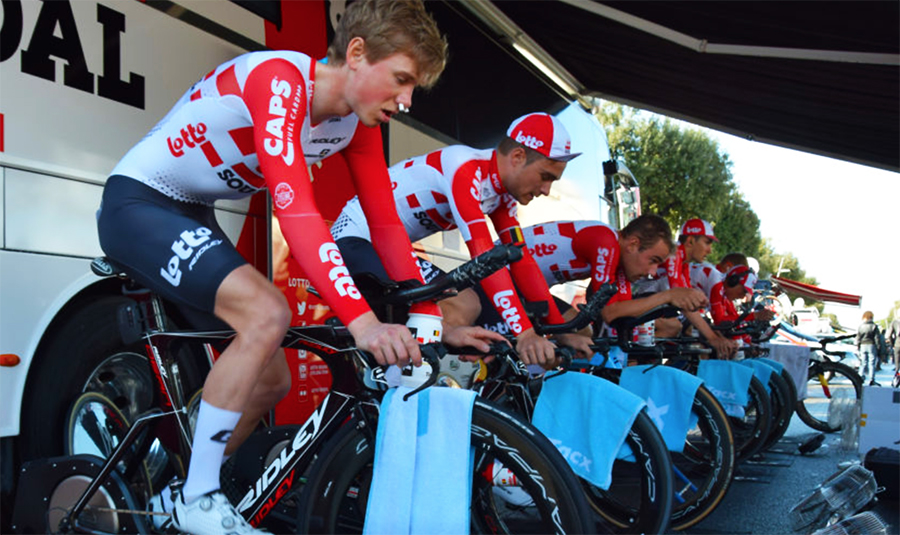By Eric Smith
<span style="color: #999999;">With each quarterly earnings call, Garmin Ltd. sheds further light on how the acquisition of Tacx is boosting the company’s top line and gross margins, although the real impact of the additional asset remains, for now anyway, unclear.
Garmin in February bought Tacx Onroerend en Roerend Goed B.V (Tacx), a privately held Dutch company that designs and manufactures indoor bike trainers, tools and accessories, as well as indoor training software and applications.
Terms of the deal weren’t disclosed, but the impact to Garmin’s top line is now showing up. On Wednesday morning Garmin released results for the second quarter—the period in which the Tacx deal was completed—and the brand’s arrival helped pad the company’s fitness revenue.
Tacx accounted for half of the 12 percent growth that Garmin reported in its fitness segment for the quarter, and the company also expects the newest member of its portfolio to account for half of all growth for the full year of 2019, CFO Doug Boessen said on Wednesday’s earnings conference call with analysts.
Revenue for the fitness segment totaled $251.7 million for the period. That helped fitness grow to 26 percent from 25 percent of the company’s total revenue in Q2, keeping it as Garmin’s largest segment ahead of outdoor, aviation, auto and marine. Fitness also posted gross margins of 54 percent and operating margins of 20 percent.
On a combined basis, the company’s fitness, aviation, marine and outdoor segments contributed 83 percent of total revenue in the quarter, up from 80 percent in the prior-year quarter.
Those marks were part of a record quarter for Olathe, KS-based Garmin, which lifted its earnings and sales guidance after reporting Q2 earnings that easily topped Wall Street’s targets.
Garmin notched revenue of $955 million, up from $894.5 million in the prior-year quarter. The company also reported gross margin of 60.3 percent, up from 58.5 percent; operating margin of 26.8 percent, up from 24.3 percent; and operating income of $256 million, up 18 percent.
The company’s GAAP diluted EPS was $1.17 and pro forma diluted EPS was $1.16, increasing 17 percent over the prior-year quarter. Wall Street’s consensus estimate had been $1.01.
The company’s other segments also fared well. Aviation grew 20 percent, while marine grew 13 percent and outdoor grew 4 percent. Auto was the only segment to decline, slipping 13 percent in the quarter.
Garmin also updated its full-year guidance, but while the company now anticipates revenue of approximately $3.6 billion driven by higher expectations for its aviation, marine and auto segments, the outlook for fitness and outdoor is unchanged.
Click here to read Garmin’s earnings recap.
<span style="color: #999999;">On Wednesday’s call, Garmin officials declined to go into too much detail on specific plans for Tacx, but Pemble said the company has a “solid roadmap” that involves investing more R&D in the brand to bring additional products to market. And Garmin is “now in the process of expanding the distribution of Tacx products through Garmin retailers.”
Pemble added, “We are in the process of integrating them into our business infrastructure including our supply chain and they are also working on updating their factory facilities in order to build trainers.”
That provides a little more clarity around Garmin’s plans for the brand, tacking onto what Pemble has said during the previous two earnings calls.
On February 20, following the company’s fourth-quarter 2018 earnings release, Pemble hinted at Garmin offering online or video classes to accompany the Tacx product line—similar to what Peloton does.
“[T]here are many different assets within Garmin and Tacx that we can now look at together and create a much more high-fidelity and interesting experience for customers that go both outside and inside,” Pemble said at the time. “So that’s our goal and we have a lot of work ahead of us for sure.”
Bringing Tacx into the fold could be a game-changer for Garmin as it enters one of the hottest fitness segments around thanks to the rise of Peloton, Wahoo and Zwift, among others.
“We’ve built a very solid cycling business based on outdoor cycling activities and so Tacx allows us to bring cycling indoors and allows us to integrate across our platforms, both in terms of head units as well as Garmin Connect,” Pemble said. “So we see a lot of opportunities and synergies that we can work together with Tacx in order to better serve the overall cycling market.”
And on May 1, following the company’s Q1 earnings release, Pemble elaborated on the acquisition, stating that Tacx will go to market as “Tacx, a Garmin company.”
He then added a few other nuggets about Tacx, including that the new asset would add about 25 percent in operating expenses year over year, and that Garmin plans to ramp up marketing and expansion of Tacx in the U.S. during the third and fourth quarters.
“In terms of bringing the product to other markets, we’re working very hard to bring it into U.S. distribution now in a more complete way,” he said. “So that’s ongoing and should be more evident as we move into the back half of the year.”
Look for the company to accelerate the profile of Tacx in the next six months as Garmin tackles opportunities in the Americas and Asia, where the brand is “less represented,” he said.
Shares of Garmin closed the day up $1.99, or 2.6 percent, to $78.59.
Photo courtesy Tacx
[author] [author_image timthumb=’on’]https://s.gravatar.com/avatar/dec6c8d990a5a173d9ae43e334e44145?s=80[/author_image] [author_info]Eric Smith is Senior Business Editor at SGB Media. Reach him at eric@sgbonline.com or 303-578-7008. Follow on Twitter or connect on LinkedIn.[/author_info] [/author]
















